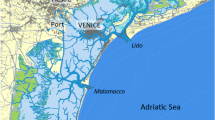Abstract
The sand hazards at Honglianghe River section of Qinghai–Tibet Railway are serious, and the effect of controlling measures is limited because the disaster-causing mechanism is currently unclear. The source of sandy materials, blown sand power environment, and controlling measures of Honglianghe River section were investigated by using methods such as field observation and analysis and indoor calculation to understand the sand hazard rules of Qinghai–Tibet Railway systematically. The sandy materials discovered are mainly from the sandy hill of the west side of the railway. In addition, the grain composition of sand with particle size in the range of 0.25–0.10 mm is given priority. Yearly sand-moving winds are usually from the N, NNW, and NW directions. The frequencies of these three wind groups accounted for 85.16 % of the yearly total. The most serious sand hazards were located at the NW direction of the railway. The yearly sand drift potential (DP) is 270.57 vector units (VU), the yearly resultant drift potential (RDP) is 247.27 VU, the yearly direction variability index (RDP/DP) is 0.91, and the yearly resultant drift direction is 162.84°. In windy dry season (during the colder half of the year), loose and broken sand materials are blown up by wind, forming wind–sand flow and movement, which are then blocked by the railway subgrade, and accumulate and thus cause disaster. We propose that the sand-controlling pattern of Qinghai–Tibet Railway is dominated by sand blocking and sand fixing, namely sand blocking in the outer fringe and sand fixing in the inner fringe, supplemented by sand transport and sand diversion, combined with vegetation. This pattern can be a significant reference to controlling sand hazards in other similar zones.














Similar content being viewed by others
References
Bagnold RA (2005) The physics of blown sand and desert dunes. Dover Publications Inc, Mineola, pp 57–76
Bullard JE (1997) A note on the use of the “fryberger method” for evaluating potential sand transport by wind. J Sediment Res 67:499–501
Genis A, Vulfson L, Ben-Asher J (2013) Combating wind erosion of sandy soils and crop damage in the coastal deserts: wind tunnel experiments. Aeolian Res 9:69–73
Hagen LJ, Casada ME (2013) Effect of canopy leaf distribution on sand transport and abrasion energy. Aeolian Res 10:37–42
Han QJ, Qu JJ, Dong ZB et al (2014) The effect of air density on sand transport structures and the adobe abrasion profile: a field wind-tunnel experiment over a wide range of altitude. Bound-Layer Meteorol 150(2):299–317
Lancaster N (1985) Wind and sand movement in the Namib sand sea. Earth Surf Proc Land 10:607–619
Lancaster N (1989) The dynamics of star dunes: an example from the Gran Desierto, Mexico. Sedimentology 36:273–289
Lettau K, Lettau H, (1977) Experimental and micrometeorological field studies of dune migration. Exploring the world’s driest climate. University of Wisconsin-Madison, pp 110–147
Liu SH, Feng LZ, Xu ZY (2010) Study on effect of wind erosion controlling in the Geermu-Lhasa section of the Qinghai–Tibet Railway. J China Railw Soc 32(1):133–136
Livingstone I, Warren A (1996) Aeolian geomorphology: an introduction. Addison Wesley Longman Limited, London, pp 22–23
Mckee ED (1979) A study of global sand seas. University Press of the Pacific, Honolulu, pp 137–169
Mujabar PS, Chandrasekar N (2013) Coastal erosion hazard and vulnerability assessment for southern coastal Tamil Nadu of India by using remote sensing and GIS. Nat Hazards 69(3):1295–1314
Shao L, Lin BL (2009) Environment impact assessment of desert railway based on fuzzy comprehensive evaluation. J China Railw Soc 31(5):84–89
Thomas DSG (1988) The nature and deposition setting of arid and semi-arid Kalahari sediments, southern Africa. J Arid Environ 14:17–26
Wasson RJ, Hyde R (1983a) A test of granulometric control of desert dune geometry. Earth Surf Proc Land 8:301–312
Wasson RJ, Hyde R (1983b) Factors determining desert dune type. Nature 304:337–339
Xie SB, Qu JJ (2013) Analyses on the types, distributions distributions and characteristics of vegetation and soil along Qinghai–Tibet Railway. Meteorolog Environ Res 4(9):15–18
Xie SB, Qu JJ, Zu RP et al (2012) New discoveries on the effects of desertification on the ground temperature of permafrost and its significance to the Qinghai–Tibet plateau. Chin Sci Bull 57(8):838–842
Xie SB, Qu JJ, Zu RP et al (2013) Effect of sandy sediments produced by the mechanical control of sand deposition on the thermal regime of underlying permafrost along the Qinghai–Tibet Railway. Land Degrad Dev 24:453–462
Yao ZY, Qu JJ (2012) Source and grain size of Aeolian aeolian sands along Golmud-Lhasa section of Qinghai–Tibet Railway. J Desert Res 32(2):300–307
Zhang KC, Niu QH, Qu JJ et al (2010a) Study on the characteristics of flow field and the mechanism of wind-blown sand disasters in the Tuotuohe region along the Qinghai–Tibet Railway. Arid Zone Res 27(2):303–308
Zhang KC, Qu JJ, Liao KT et al (2010b) Damage by wind-blown sand and its control along Qinghai–Tibet Railway in China. Aeolian Res 1:143–146
Zhou D, Tian HQ, Yang MZ et al (2007) Comparison of aerodynamic performance of different kinds wagons running on embankment of the Qinghai–Tibet Railway under strong cross-wind. J China Railw Soc 29(5):32–36
Acknowledgments
This research project funded by the National Natural Science Foundation of China (Grant No. 41401611), China Postdoctoral Science Foundation (Grant No. 2014M560817), Foundation for Excellent Youth Scholars of Cold and Arid Regions Environmental and Engineering Research Institute, Chinese Academy of Sciences (Grant No. 51Y351121), and Science and technology program of Gansu Province (Grant No. 145RJZA118). The authors would like to thank the two anonymous reviewers’ useful comments and the editor’s valuable suggestions for improving this manuscript.
Author information
Authors and Affiliations
Corresponding author
Rights and permissions
About this article
Cite this article
Xie, S., Qu, J., Lai, Y. et al. Formation mechanism and suitable controlling pattern of sand hazards at Honglianghe River section of Qinghai–Tibet Railway. Nat Hazards 76, 855–871 (2015). https://doi.org/10.1007/s11069-014-1523-7
Received:
Accepted:
Published:
Issue Date:
DOI: https://doi.org/10.1007/s11069-014-1523-7




